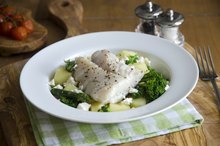What does fact checked mean?
At Healthfully, we strive to deliver objective content that is accurate and up-to-date. Our team periodically reviews articles in order to ensure content quality. The sources cited below consist of evidence from peer-reviewed journals, prominent medical organizations, academic associations, and government data.
The information contained on this site is for informational purposes only, and should not be used as a substitute for the advice of a professional health care provider. Please check with the appropriate physician regarding health questions and concerns. Although we strive to deliver accurate and up-to-date information, no guarantee to that effect is made.
Nutrition Data & Facts on Trout
There are a number of different trout species in the United States, such as lake, brook, rainbow and bull. Perhaps to offer a general idea of this freshwater fish’s nutritional value -- in view of so many different species -- the U.S. Department of Agriculture has one nutrition facts label that refers to the nutrients in mixed species of trout 12.
Fish Facts
The largest trout species is the lake trout, a native of the Great Lakes, Alaska and Canada that can weigh as much as 100 pounds. The spotted brook trout grows to 10 inches and lives in an area that ranges from Canada to southern Georgia in the U.S. Brook trout spawns in the fall, with eggs hatching in spring. The rainbow trout is a freshwater fish, but some follow the path of a river into the ocean, where they can survive; however, to spawn, they have to return to the river. The bull trout is a light yellow fish with red markings that swims in western states, from Oregon and Washington to Idaho and Montana. According to the U.S. Fish and Wildlife Service, the species does not adapt to adverse conditions, such as unclear and warm waters or reduced flow. Unable to survive and reproduce, the bull trout disappears in unfavorable environments.
- The largest trout species is the lake trout, a native of the Great Lakes, Alaska and Canada that can weigh as much as 100 pounds.
- The rainbow trout is a freshwater fish, but some follow the path of a river into the ocean, where they can survive; however, to spawn, they have to return to the river.
General Vitamin Content
Fish & Chicken Diet
Learn More
Based on a 2,000-calorie diet, one cooked trout filet weighing about 2 ounces has 1 percent of the recommended daily intake for vitamin A. The nutrient is an antioxidant that neutralizes disease-causing molecules known as free radicals. The serving also provides seven of the B-complex vitamins: It contains 77 percent of the RDI for B12, 18 percent for thiamin and niacin, 15 percent for riboflavin, 14 percent for pantothenic acid, 7 percent for B6, and 2 percent for folate. As a group, the B vitamins facilitate digestion, making it possible for your body to extract energy from foods.
- Based on a 2,000-calorie diet, one cooked trout filet weighing about 2 ounces has 1 percent of the recommended daily intake for vitamin A.
- The nutrient is an antioxidant that neutralizes disease-causing molecules known as free radicals.
- As a group, the B vitamins facilitate digestion, making it possible for your body to extract energy from foods.
General Mineral Content
Trout has all essential minerals in varying amounts. The cooked fish provides 3 percent of the RDI for calcium, 7 percent for iron and copper, 4 percent for magnesium and zinc, 19 percent for phosphorous, 6 percent for potassium, 2 percent for sodium, 34 percent for manganese and 14 percent for selenium. Minerals play different roles to help your various systems to function. Potassium, for example, is an electrolyte. The nutrient powers your tissues, cells and organs with the electrical signals it transmits.
- Trout has all essential minerals in varying amounts.
- Minerals play different roles to help your various systems to function.
Additional Nutrition
The Nutritional Values of Freshwater Fish
Learn More
Trout is rich in amino acids, the precursors of proteins. One 2-ounce fillet contains sufficient amino acids for your body to produce 33 percent of the recommended daily intake for protein. It also provides 8 percent of the RDI for fat and gives you 118 calories, fuel that takes 25 minutes of moderate walking to burn.
Related Articles
References
- SkipThePie.org: Nutritional Info: Fish, Trout, Mixed Species, Cooked, Dry Heat
- Maryland Fish Facts: Brook Trout
- U.S. Fish and Wildlife Service: Bull Trout Facts (Salvelinus Confluentus)
- MedlinePlus: Vitamin A
- American Cancer Society: Vitamin B Complex
- University of Maryland Medical Center: Potassium
- FoodData Central. Fish, trout, rainbow, wild, raw. U.S. Department of Agriculture. Updated 2019.
- Dietary Guidelines Recommendations 2015-2020. Office of Disease Prevention and Health Promotion.
- Fish and Omega-3 Fatty Acids. The American Heart Association. Updated 2016).
- Chaddha A, Eagle KA. Cardiology Patient Page. Omega-3 Fatty Acids and Heart Health. Circulation. 2015;132(22):e350-2. doi:10.1161/CIRCULATIONAHA.114.015176
- Nutrition During Pregnancy. American College of Obstetricians and Gynecologists. 2020
- Omega-3 Fatty Acids. National Institutes of Health Office of Dietary Supplements. Updated 2019.
- Vitamin D. National Institutes of Health Office of Dietary Supplements. Updated 2020.
- Food allergy. American College of Allergy, Asthma, and Immunology. Updated. 2014.
- Selecting and serving fresh and frozen seafood safely. U.S. Food and Drug Administration. Updated 2019.
Writer Bio
Emma Watkins writes on finance, fitness and gardening. Her articles and essays have appeared in "Writer's Digest," "The Writer," "From House to Home," "Big Apple Parent" and other online and print venues. Watkins holds a Master of Arts in psychology.








